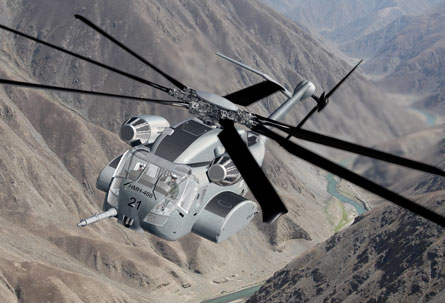Two extremes divide the current market for large turboshaft engines. Europrop International occupies the high-end with the more than 10,000shp (7,460kW)-class TP400-D6. Rolls-Royce dominates the low-end with the 6,000shp-class AE2100/1107C family.
Between these extremes lies a vacant, vast middle ground ripe for development and growth over the next few decades.
First to market in this unpopulated region will be General Electric's 7,500shp GE38-1B, selected 18 months ago to power the US Marine Corps' 38,400kg (84,700lb) Sikorsky CH-53K transport helicopter (below).
 |
|---|
© Sikorsky |
GE has finally disclosed the first details about the GE38's closely held development programme, and offered a glimpse of its vision for the heavylift market space.
Ed Birtwell, GE's vice-president and general manager for turboshaft engines, compares the new GE38's market potential with that of the company's flagship T700, a 3,000shp-class engine that powers thousands of Sikorsky UH-60 Black Hawk utility and Boeing AH-64 Apache attack helicopters, among many others.
"We hope that this is a programme that has the success of the T700 with other applications," Birtwell says.
To realise that potential, new classes of heavylift helicopters and medium-lift, fixed-wing transports will have to emerge over the next decade. The market could include growth versions of existing helicopters like the CH-53K, as well as possibly all-new aircraft.
"We will always have a huge need for medium-lift helicopters like the Black Hawk," says Rhett Flater, executive director of the American Helicopter Society. "On the other hand, some of the experiences that the US Marine Corps and the army have encountered in Afghanistan in particular, but also Iraq, justify the need for helicopters capable of carrying heavier payloads."
Another option for GE could be capturing a share of R-R's grip on the heavylift market.
The USMC is investigating the GE38-1B as a replacement for the AE1107C that powers the Bell Boeing MV-22 Osprey, a medium-lift tiltrotor. USMC officials have expressed concerns about the durability of the AE1107C after experiencing sand ingestion in Iraq.
 |
|---|
© US Navy |
"The AE1107C compressor does not currently take advantage of protective coatings to minimise sand and dust erosion," R-R says. "However, we have outlined with the customer an engine coating programme to begin in-service evaluations in the near future."
Lockheed Martin also may have to upgrade the payload capacity of the venerable C-130J Hercules, as the size of the vehicles for the army's Future Combat System grows from about 20t to about 27t. At that time, the GE38 may be viewed as an attractive alternative to the AE2100.
Birtwell declines to comment about specific opportunities for the GE38 beyond the CH-53K, but clearly describes GE's strong interest in pursuing those options.
"GE made an investment in this programme as well. It's not just government money," Birtwell says. "We did it for a reason. We are highly aware of the various other applications in this power class."
GE's competitors are also well aware of this potential new market. Honeywell builds the 5,000shp T55-GA-714 engine for newer-model Boeing CH-47 Chinooks, and has advertised a more powerful, next-generation version called the 55-L-71X.
Facing such competitive pressure, GE is holding off on concepts for future applications to focus on delivering the GE38-1B on time for Sikorsky's CH-53K programme.
"We do need to focus on this one particular job, because we want to get the engine right first and then we can work on other things," Birtwell says. In June, GE released engineering drawings for engine parts to the supply chain, he says. Passing that internal milestone means the company has finalised design of the engine components, allowing fabrication of parts to begin for the first engine to test.
The first rig test is scheduled in July to analyse the combustor. That will be followed by a second rig test in the first quarter of 2009 to check the lubrication system at various engine attitudes in pitch and yaw.
The first complete engine to test is scheduled to be installed on GE's test stand in the first half of next year. GE is building 20 engines to support 6,000h of flight testing on five prototype CH-53Ks.
The GE38-1B emerged as an outgrowth of the GE27 "mature technology demonstrator engine" in the 1980s and the T407 was proposed for the subsequently cancelled Lockheed P-7 patrol aircraft. The GE38-1B is based on the same architecture, but boasts 20% more power than the T407 driven by an updated core hot section and a redesigned power turbine.
For the CH-53K, GE was initially prepared to offer a growth version of the GE T64 engines that now power the CH-53E fleet.
However, "as the requirement evolved the power requirement got to be such that it was more than the T64 architecture could handle," Birtwell says.
Source: Flight International
















